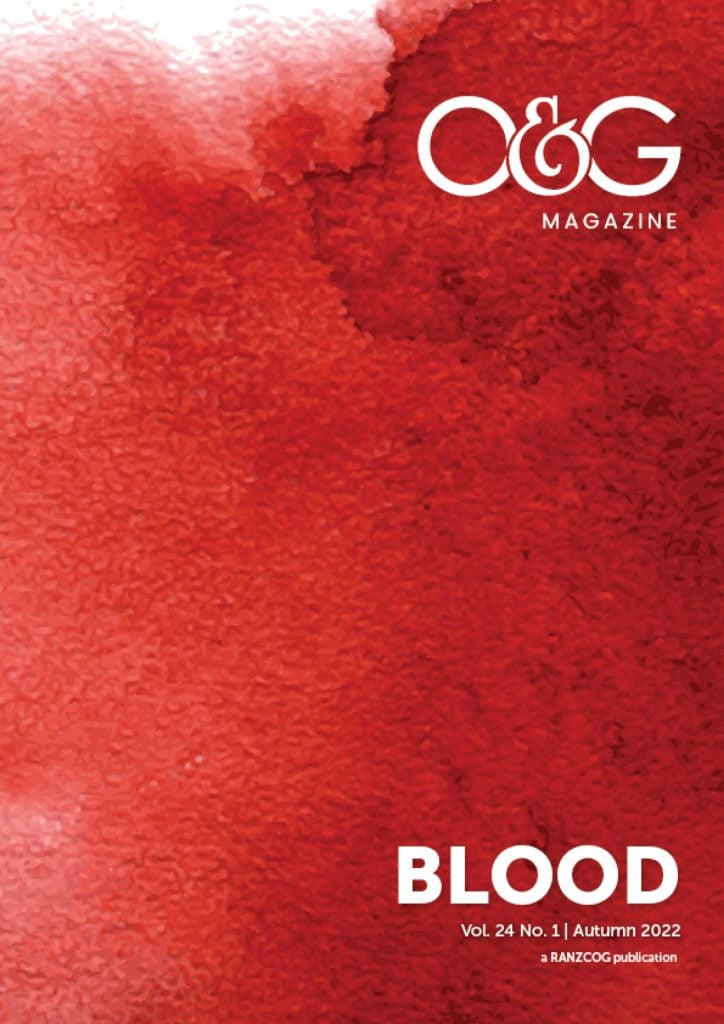Postpartum haemorrhage (PPH) is common. It is a source of significant morbidity and mortality for pregnant women, especially in low-income countries.1 However, probably most pertinent of all, the disease burden of PPH is largely preventable. The local incidence of PPH as a cause of maternal death has been on the rise. This is contrary to the overall rate of maternal mortality which has been on the decline in Australia and New Zealand.2
RANZCOG defines PPH as the loss of 500ml or more of blood from the genital tract within 24 hours of the birth of a baby. A PPH is considered major if the blood loss exceeds 1000ml and severe if it exceeds 2000ml.3
This article addresses some interesting literature on severe PPH and obstetric blood management and provides insight into an obstetric anaesthetist’s management perspective.
Massive obstetric haemorrhage: what the data shows
Understanding contributing predictors for severe complications is a logical step towards improving outcomes. This can help clinicians lead these at-risk women onto the appropriate clinical pathways and escalation of level of care.
In 2020, Lasica et al published one of the largest reported studies on massive obstetric haemorrhage (MOH) and transfusion management.4 It was a bi-national (Australia and New Zealand) cohort study which included 19 hospitals and 249 cases of MOH. The definition used for MOH was bleeding requiring ≥5 units of red blood cells (RBC) within four hours. Data from the registry (2008–2015) showed that two-thirds of MOH occurred in the out of hours period. Another major finding was that a significant percentage (52%) of MOH cases in this study recorded a low fibrinogen level (<2 g/l) in the first 24 hours after commencement of massive transfusion. It also demonstrated independent risk factors for emergency hysterectomy (see Table 1).
Other relevant findings were:
- Predominant causes of MOH were uterine atony (22%), placenta praevia (20%) and obstetric trauma (19%)
- 44% of cases required intensive care unit admission
- 29% of cases required hysterectomy
- Three cases died
This data highlights key issues when assessing risk of complications associated with MOH. It also demonstrates the level of associated morbidity and mortality in our local (high income) setting
and emphasises the important role of timely, adequate replacement of fibrinogen within the resuscitative management.
Table 1. Risk factors for emergency hysterectomy with MOH. Values expressed as odd ratios and 95% confidence intervals.
| Risk factor | Odds ratio | 95% confidence interval |
|---|---|---|
| Emergency caesarean section | 4.9 | 2.0–11.7 |
| Placenta praevia | 7.2 | 2.0–26.4 |
| Transfusion of ≥ 6 units of RBC prior to first unit of cryoprecipitate | 3.5 | 1.7–7.2 |
Blood transfusion targets
There is no longer debate on the adverse effects of anaemia on the pregnant woman and her baby. The exhaustive list of these includes (but is not limited to):
- Neonatal: low birth weight, preterm birth, perinatal mortality5 6
- Maternal: peripartum infection, PPH and transfusion, preeclampsia, mental health issues, fatigue and maternal mortality7 8 9 10
The most common definition of anaemia is from the World Health Organization (WHO), which defines anaemia as a haemoglobin level of <120 g/l for women and <110 g/l for pregnant women. Severe anaemia during pregnancy is further defined as a haemoglobin level < 70 g/l.11 However, more recently, Ferguson and Dennis have challenged these definitions which were established in 1968. These authors point to more contemporary data which suggests that haemoglobin levels in iron-replete pregnant women are higher than previously perceived.12 Even mild anaemia can give rise to adverse outcomes in pregnant women and thus a definition of anaemia which may underestimate the ‘normal’ haemoglobin level of a pregnant woman is clearly undesirable. This is the importance of re-examining the target and threshold of optimal haemoglobin in pregnant women. The Australian National Blood Authority suggest that a reasonable range for normal pregnancy haemoglobin levels is between 103–146 g/l.13 This range also takes into consideration the potential complications of blood and blood products transfusion and the independent adverse effects of a high Hb in pregnant women.14
Anecdotally, the majority of anaesthetists in our institution would decide to transfuse blood at a haemoglobin level < 70 g/l or additionally at a haemoglobin level < 90 g/l if bleeding is ongoing or the woman shows signs of haemodynamic instability and adequate crystalloid volume has already been administered. The latter step is a subjective assessment by the treating clinician so as to avoid excessive dilution of circulating clotting factors which would contribute to a dilutional coagulopathy.
Key management principles
The National Blood Authority (Australia) has published guidelines specifically addressing patient blood management in the obstetrics and maternity setting. This is a comprehensive document created through multi-disciplinary collaboration of all key stakeholders. The current version is under review. On the topic of critical obstetric bleeding, these guidelines strongly recommend a structured and planned approach to escalate procedures, administer blood (and blood products) and manage obstetric haemorrhage when it develops rapidly. Frequent clinical assessment is key and should be supplemented with measurements of temperature, acid-base status, ionised calcium, haemoglobin, platelet count and coagulation profile. The key aim being the avoidance of the lethal combination of hypothermia, hypocalcaemia, acidosis and coagulopathy whilst achieving adequate resuscitation of the bleeding patient.15
It is worth noting that a large proportion of major PPH occurs post vaginal delivery with or without instrumental assistance.16 This subgroup may or may not require anaesthetic involvement. However, the practicalities and fundamentals of management overlap significantly whether in an operating theatre or in the labour ward.
Resuscitation and management of a woman having a severe PPH is a complex scenario. The cognitive load is high and the interplay with human factors is significant. At our institution, there are dedicated policies, guidelines and cognitive aids.17 All team member roles are clearly delineated. This includes obstetrics, anaesthetics, haematology, midwifery, nursing, laboratory, theatre technician and a team leader. As with all critical medical scenarios, good leadership and followship is crucial, with concise and frequent closed loop communication allowing smooth and efficient care whilst minimising errors. Cognitive aids provide mental assistance to staff (especially those in training) in stressful conditions in order to facilitate timely stepwise escalation in medical and surgical interventions. That being said, early senior clinician involvement is recommended in these cases.
Conclusion
Severe PPH has associated morbidity and mortality even in high income health systems. A clinician’s understanding of the factors that contribute to associated complications are pivotal to triggering appropriate care responses. The main ones are emergency after-hours cases, abnormal placentation and low fibrinogen levels that have not been replaced despite massive blood transfusion occurring. Management of a severe PPH is a team game and best practice includes having a pre-planned systematic approach which encompasses modern day transfusion targets.
Our feature articles represent the views of our authors and do not necessarily represent the views of the Royal Australian and New Zealand College of Obstetricians and Gynaecologists (RANZCOG), who publish O&G Magazine. While we make every effort to ensure that the information we share is accurate, we welcome any comments, suggestions or correction of errors in our comments section below, or by emailing the editor at [email protected].
References
- Kassebaum NJ, Bertozzi-Villa A, Coggeshall MS, et al. Global, regional, and national levels and causes of maternal mortality during 1990-2013: a systematic analysis for the Global Burden of Disease Study 2013. Lancet. 2014;384(9947):980-1004.
- Australian Institute of Health and Welfare. Australia’s mothers and babies web report 2021. Available from: www.aihw.gov.au/getmedia/bba093ef-a623-4cfd-818b-1bb5af9f0d20/Australia-s-mothers-and-babies.pdf.aspx?inline=true.
- Mavrides E, Allard S, Chandraharan E, et al on behalf of the Royal College of Obstetricians and Gynaecologists. Prevention and management of postpartum haemorrhage. BJOG. 2016;124:e106–e149.
- Lasica M, Sparrow RL, Tacey M, et al. Haematological features, transfusion management and outcomes of massive obstetric haemorrhage: findings from the Australian and New Zealand Massive Transfusion Registry. Br J Haematol. 2020;190(4):618-28.
- Nair M, Choudhury MK, Choudhury SS, et al. Association between maternal anaemia and pregnancy outcomes: a cohort study in Assam, India. BMJ Glob Health. 2016;1(1):e000026.
- Rahman MM, Abe SK, Rahman MS, et al. Maternal anemia and risk of adverse birth and health outcomes in low- and middle-income countries: systematic review and meta-analysis. Am J Clin Nutr. 2016;103(2):495-504.
- Nair M, Choudhury MK, Choudhury SS, et al. Association between maternal anaemia and pregnancy outcomes: a cohort study in Assam, India. BMJ Glob Health. 2016;1(1):e000026.
- Rukuni R, Bhattacharya S, Murphy MF, et al. Maternal and neonatal outcomes of antenatal anemia in a Scottish population: a retrospective cohort study. Acta Obstet Gynecol Scand. 2016;95(5):555-64.
- Ali AA, Rayis DA, Abdallah TM, et al. Severe anaemia is associated with a higher risk for preeclampsia and poor perinatal outcomes in Kassala hospital, eastern Sudan. BMC Res Notes. 2011;4:311.
- Brabin BJ, Hakimi M, Pelletier D. An analysis of anemia and pregnancy-related maternal mortality. J Nutr. 2001;131(2S-2):604S-14S; discussion 14S-15S.
- WHO. Haemoglobin concentrations for the diagnosis of anaemia and assessment of severity. Vitamin and Mineral Nutrition Information System. Geneva, World Health Organization, 2011 (WHO/NMH/NHD/MNM/11.1) Available from: www.who.int/vmnis/indicators/haemoglobin.pdf
- Ferguson MT, Dennis AT. Defining peri-operative anaemia in pregnant women – challenging the status quo. Anaesthesia. 2019;74(2):237-45.
- National Blood Authority Australia. Patient Blood Management Guidelines: Module 5 Obstetrics and Maternity 2015. Available from: www.blood.gov.au/system/files/documents/20180426-Module5-WEB.pdf
- Stephansson O, Dickman PW, Johansson A, Cnattingius S. Maternal hemoglobin concentration during pregnancy and risk of stillbirth. Journal of the American Medical Association. 2000;284(20):2611–7.
- National Blood Authority Australia. Patient Blood Management Guidelines: Module 5 Obstetrics and Maternity 2015. Available from: www.blood.gov.au/system/files/documents/20180426-Module5-WEB.pdf
- Lasica M, Sparrow RL, Tacey M, et al. Haematological features, transfusion management and outcomes of massive obstetric haemorrhage: findings from the Australian and New Zealand Massive Transfusion Registry. Br J Haematol. 2020;190(4):618-28.
- Royal Women’s Hospital (VIC). Postpartum Haemorrhage Guideline. 2021.






Leave a Reply